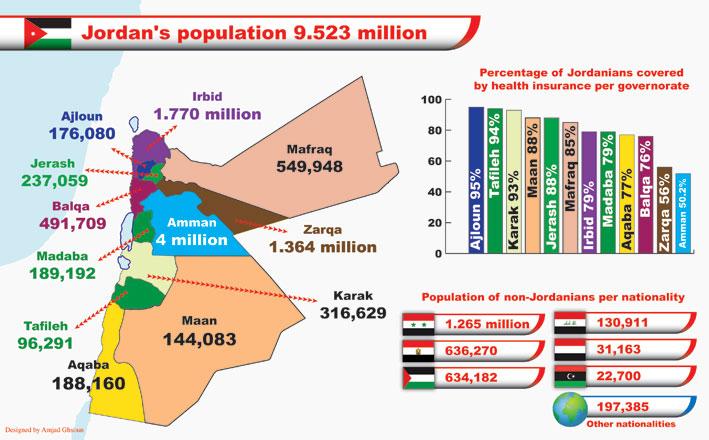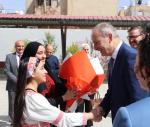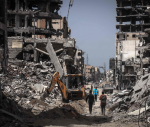You are here
Population stands at around 9.5 million, including 2.9 million guests
By Mohammad Ghazal - Jan 30,2016 - Last updated at Jan 30,2016

AMMAN — Syrians constitute 46 per cent of non-Jordanians living in the Kingdom and 13.2 per cent of the overall population, preliminary results of the national census conducted in late November showed on Saturday.
Of Jordan’s total population of 9.5 million, the number of Jordanians is around 6.6 million, while the number of non-Jordanians who reside in the country is around 2.9 million, representing 30.6 per cent of overall population, according to the results announced Saturday by Department of Statistics Director General Qasem Zu’bi.
In regard to governorates, the results showed that 4 million people, or 42 per cent of the population, live in Amman, 1.770 million in Irbid, 1.364 million in Zarqa, 549,948 in Mafraq, 491,709 in Balqa, 316,629 in Karak, 237,059 in Jerash, 189,192 in Madaba, 188,160 in Aqaba, 176,080 in Ajloun, 144,083 in Maan and 96,291 in Tafileh.
Of the total non-Jordanian population, 1.265 million are Syrians, followed by Egyptians, totalling 636,270 representing 6.68 per cent of the population and Palestinians who do not have national ID numbers with 634,182 representing 6.65 per cent of the population.
Iraqi nationals come next with 130,911 representing 1.3 per cent of the population, Yemenis with 31,163 representing 0.33 per cent of the population and 22,700 Libyans representing 0.24 per cent of the population. Around 197,385 people of several other nationalities also reside in Jordan, accounting for 2.07 per cent of the population.
The figures showed that 49.7 per cent of the non-Jordanians residing in the Kingdom live in Amman, while 38.6 per cent of Jordanians live in the capital.
On the distribution of Syrians living in Jordan, 435,578 Syrians live in Amman, 343,479 in Irbid, 207,903 in Mafraq, 175,280 in Zarqa and the rest are distributed across the country’s other governorates.
Of the Palestinians who do not have national ID numbers, 308,091 live in Amman, 189,788 live in Zarqa, and 53,628 live in Jerash, while the rest live across the country’s other governorates, according to the figures.
The census, which covered 1.977 million families, indicated that the largest increase in population was in 2011. Annual population growth in 2004-2015 stood at 5.3 per cent, the census showed, attributing the rise to the waves of refugees into the Kingdom.
The average size of families living in Jordan dropped from 6.7 people in 1979 to 4.8 in 2015.
The figures indicated that half of the country’s population is covered by health insurance.
Among Jordanians, two thirds, or 66.6 per cent, have health insurance.
Of Jordanians living in the capital, 50.2 per cent have health insurance, while the percentage is higher in all the other governorates.
The percentage of Jordanians with health insurance in Balqa is 76 per cent, Zarqa 56 per cent, Madaba 79 per cent, Irbid 79 per cent, Mafraq 85 per cent, Jerash 88 per cent, Ajloun 95 per cent, Karak 93 per cent, Tafileh 94 per cent, Maan 88 per cent and Aqaba 77 per cent.
















